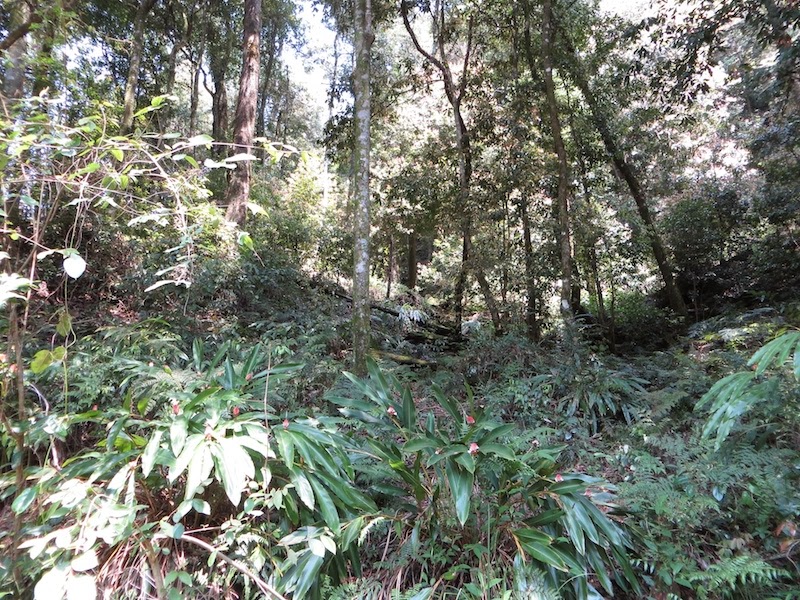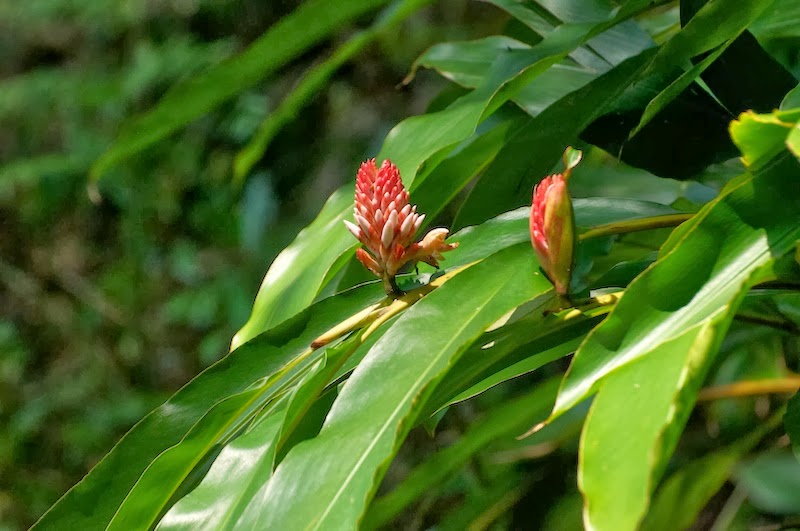Swinhoe's Pheasant (Lophura swinhoii), a species once reduced to less than 200 individuals in the wild, is a bird of lower elevations than the Mikado Pheasant, mostly below 1000 metres (though it can range higher, up to 2500 m). This time, then, we set off not uphill but down, following the road into dense, deep green broadleaf forest.
We had not far to go. Well before we reached the traditional Swinhoe's stakeout point, we came across a female showing great interest in a gutter at a bend in the road.
We soon found out why. At the bottom of the gutter were a brood of chicks - whether they had gotten there by accident or design, we couldn't say.
The chicks were particularly attractive little birds, beautifully patterned in black, grey and buff with a rich chestnut wash over the crown.
Their mother seemed to be trying to show her brood how to get out of the gutter…
…but the chicks, though they certainly tried, couldn't manage it. We thought we would only make matters worse by interfering (and were concerned that just by being there we were adding to the tension of the situation), so after watching the family for a few minutes we reluctantly moved on.
The usual drill for seeing Swinhoe's is much the same as for the Mikado Pheasant: drive to the right spot, put out some attractive bait, get your camera ready, and work on the assumption that If You Feed Them, They Will Come…
…and it works!
After the sombre and elegant beauty of the Mikado, the male Swinhoe's Pheasant is almost garish.
The effect is pronounced by the bird's ability, when excited (either by us or by the presence of a nearby female in the undergrowth) to pump blood into its facial watches and comb, spreading them out to cover most of its face.
At the height of his excitement, even his bill vanishes from view.
It didn't hurt that our bird strutted repeatedly almost to our feet, flaunting his colours at us as he did so.
Of course we saw other birds, too - Swinhoe's Pheasant is not the only species that has learned that crazy humans scatter bait on the roadside. Others included a female White-tailed Robin (Myiomela leucura montium)…
…and one of the most attractive (and common) of Taiwan's endemic birds, Steere's Liocichla (Liocichla steerii).
Perny's Long-nosed Squirrels (Dremomys pernyi owstoni) were as eager for a handout here as they were at the Mikado Pheasant stakeout higher up the mountain.
Our pheasant had wandered off for a bit, but just as we were about to head off ourselves he treated us to a mid-morning encore.
This time, he seemed considerably more excited - a female had emerged onto the roadside, an opportunity he was not about to pass by without some response.
Eventually the pheasants grew tired of us and stalked off into the trees. We were free to pursue other forest birds - and to take in some of the forest where they lived.
The understory at this elevation was heavy and seemingly diverse, dominated in places by thick clumps of ginger (at least along the roadside).
Gingers are widely cultivated in Taiwan, so I am not sure if the roadside plants at Dasyueshan were wild or escapes. We were there early in the season, and their flower heads were just beginning to open, making identification tricky.
I think, though, that these are a species of Alpinia - ginger experts out there, please feel free to comment!
Whatever they are, they were most attractive, even in bud.
I am on a bit firmer ground here - but then any naturalist from Ontario would recognize this plant as a cousin of our Jack-in-the-Pulpit (Arisaema triphyllum), though Asian members of this aroid group are usually called cobra lilies. Arisaema is one of those interesting plant genera found in both eastern North America (where there are only a few species) and Eastern Asia (with far more, spreading to southern Asia and East Africa in this case), but not in between. I was very interested to see it blooming by the roadside, and Bob kindly found me a clump to photograph.
Anyway, there are several in Taiwan. As this one has only 10 or so leaflets (see photo above) it is probably Arisaema formosanum, which is recorded from Dasyueshan. Well, I think so anyway.
This roadside rest stop was a spot for one of Taiwan's more elusive endemics, the Yellow Tit (Parus holsti). I had only the briefest glimpse of a bird in a treetop, but this stretch of roadside was beautiful and productive all the same.
I include this shot - our only raptor - not so much because it is good (it isn't) but in the hope that someone out there can confirm my identification. I'm tentatively calling it a Crested Goshawk (Accipiter trivirgatus) for lack of anything that fits better, but I'm not happy about it.
This isn't a terrific shot either (better ones will come in a later entry) but it introduces you to one of Taiwan's most charming endemics, the Taiwan Yuhina (Yuhina brunneiceps). Yuhinas are now known to be close to the white-eyes (in the same babbler subfamily, Zosteropinae), and like them travel through the trees in active twittering flocks.
So do Black-throated Tits (Aegithalos concinnus), though we saw far fewer of them than we did of the yuhinas.
The Ferruginous Flycatcher (Muscicapa ferruginea) is a bird I also see now and again in West Malaysia, where it is a migrant and winter visitor (it is a rarity in Borneo).
Another bird shared by both Taiwan and Borneo (where it is a montane species common on Mount Kinabalu) is the Grey-chinned Minivet (Pericrocotus solaris griseogularis). This is a male.
In short, as a birding spot Dasyueshan deserved its reputation. We spent quite a bit of time in the forest - more than we intended, actually, because Bob's car developed a bit of trouble and we had to wait for a service truck to make its way up from the lowlands. Mind you, I didn't 't mind the extra time in this beautiful place one bit!



+DSC_7955.jpg)
+DSC_7966.jpg)
+DSC_7959.jpg)
+DSC_7963.jpg)
+DSC_7968.jpg)
+DSC_7964.jpg)
+DSC_7969.jpg)
+DSC_7967.jpg)

+DSC_7977.jpg)
+DSC_7999.jpg)
+DSC_8004.jpg)
+DSC_8067.jpg)
+DSC_8034.jpg)
+DSC_8036.jpg)
+DSC_8019.jpg)
+DSC_8030.jpg)
+DSC_8031.jpg)
+DSC_8009.jpg)
+DSC_7982.jpg)
+DSC_8050.jpg)
+DSC_7992.jpg)
+DSC_8054.jpg)
+DSC_7993.jpg)
+DSC_8046.jpg)
+DSC_8052.jpg)

+DSC_8077.jpg)
+DSC_8070.jpg)
+DSC_8072.jpg)
+DSC_8073.jpg)
+DSC_8079.jpg)
+DSC_8090.jpg)















+DSC_8048.jpg)
+DSC_8119.jpg)
+DSC_8148.jpg)
+DSC_8134.jpg)
+DSC_8121.jpg)
